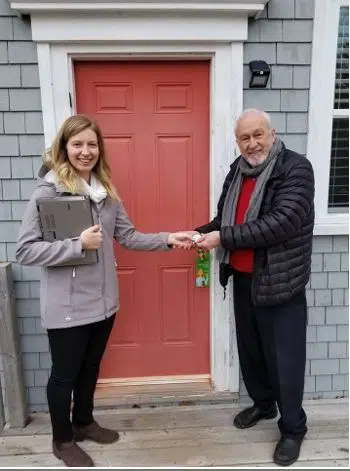
Katherine Dorey and Mayor David Devenne after he was the first person to complete the towns' GHG emission survey. Photo: Town of Mahone Bay
Mahone Bay is almost done with its Greenhouse Gas Reduction (GHG) Plan as it’s now set to be given to the community, after which they will be able to raise any concerns.
The first step of the plan was to get an inventory of the town’s GHG emissions.
With funding from the 2020 Provincial Low Carbon Communities fund, the town was able to hire Katherine Dorey to spearhead the data collection.
In her role as Climate and Energy Outreach Coordinator, Dorey had originally planned to organize a door-to-door survey of residents, gathering residential data on greenhouse emissions. That had to be called off due to the COVID-19 pandemic and instead, the town opted to do an online survey.
With 60 percent of Mahone Bay residents filling out the survey the town now believes they have a relatively accurate idea of where their emissions come from.
The initial report found that the three largest contributors to greenhouse emissions are electricity, transportation, and construction.
Mayor David Devenne says electricity is on that list because of the town still purchases around 60 per cent of its power from Nova Scotia Power and New Brunswick Power who both generate electricity with methods that generate a large amount of greenhouse gas.
However, Mahone Bay is working to get away from outside providers of power as they are one of a few remaining Nova Scotia communities that own their own utility.
Devenee says, “Currently our wind farm generates about 45 per cent of our power and with the addition of the solar farm forthcoming that will add another 12 to 18 per cent.”
By owning their own utility the town has more freedom to get away from the larger power companies and chart their own path. The GHG Plan sets a goal of using 100 per cent renewable energy sources by 2050.
Now having identified the sources of GHG emission the town will use the plan to guide its policies that will work toward reducing emission from the three biggest contributors.
The GHG Plan will be presented to the public on March 10, at 7 p.m. Staff will provide a general overview of the Plan and actions proposed, allowing time for questions. The Plan itself is available on the Town webpage where comments can be submitted via the comment form, or emailed to climate@townofmahonebay.ca.
Once community engagement is complete a final draft will be presented for the council to vote on.








